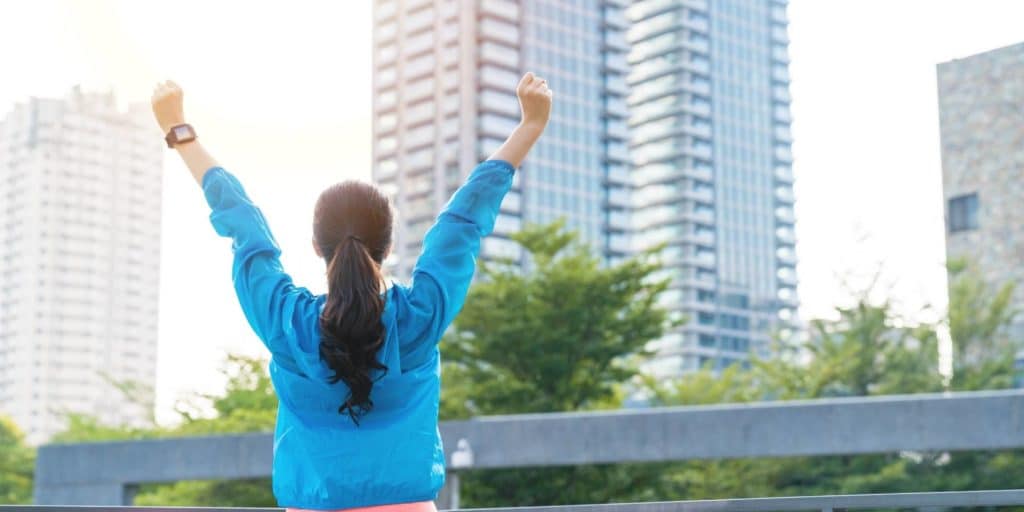Have you head about elite athletes working with sports psychologists and using mental imagery or visualisation techniques in order to enhance their performance? These imagery techniques for athletes are not solely for the elite and can be used by anyone looking to improve their performance.
Imagery can be effective at any level of training or competition. It can bring you closer to realising your true potential, whether that is squatting a certain weight, running a desired time, or improving a technical skill, such as a golf swing.
What Is Imagery?
Imagery is the creation and rehearsal of a positive mental experience in the mind in order to enhance your ability to achieve a successful outcome. Although the terms ‘imagery’ and ‘visualisation’ are used, imagery should involve all of the senses, not just visual, thus you need to think about the movements, feelings and sensations that go into your performance.
How Do Elite Athletes Use Imagery Techniques?
Visualisation is a skill you often see athletes using prior to competition to mentally rehearse every aspect of their event. This can particularly be seen in fly-halves in rugby, for example when Owen Farrell, England fly-half is making a conversion or taking a penalty, you can see him mentally visualising the trajectory of the ball (with crazy eyes) several times before taking the strike.
In fact, these days nearly all elite athletes employ some form of visualisation to improve their sports performance. Jonny Wilkinson, former England RU fly-half explained how he used imagery techniques to prepare for World Cup matches: “You create the sights, sounds and smells, the atmosphere, the sensation and the nerves, right down to the early morning wake-up call and that feeling in your stomach. It helps your body to get used to performing well under pressure”.
Athletes such as Andy Murray, British Tennis player and current world #2 apparently makes several visits to a deserted Centre Court before Wimbledon in order to mentally acclimatise to the environment and perform his visualisation techniques in the place where he will be performing. Also, the most decorated Olympian of all time, American swimmer Michael Phelps, with 18 gold medals to his name claims that his success stems from his use of visualisation techniques, by watching his ‘videotape’ of the perfect swim in his mind each night before going to sleep to mentally map out his ideal swim for the next day.
Why Should You Use Imagery Techniques if You’re Not an Elite Athlete?
Imagery techniques have been shown to help build confidence, enhance motivation, control emotional responses, improve concentration, focus, coordination, clarity and speed of thought, and to allow the person to practise and correct sports skills, prepare for competition, cope with pain and injury and also reduce fear and anxiety.
How Does Imagery Techniques Work?

According to research using brain imagery, visualisation works because neurons in our brains, (electrically excitable cells that transmit information), interpret imagery as equivalent to real-life actions. So when you are imagining performing a particular sport skill, the brain will send small nervous impulses to the muscles and although these nervous impulses are not strong enough to produce a muscular contraction, they will start to establish a nervous pathway and fire in the same sequence as they would if you were actually performing the skill.
Of course, these changes aren’t as great as those that occur when you actually perform the activity. However, when you physically practise the skill, the nervous pathway will become reinforced and stronger. The nervous system will eventually send the correct messages in the correct sequence because the pathway already exists.
Steps to Make Imagery Techniques for Athletes Work for You to Achieve Your Fitness Goals
Step 1 – Goal Setting
The first step is to clearly define a highly specific goal, e.g. running a marathon in a certain time, lifting a certain weight. In order to succeed in reaching your goal, you need to have an idea of what it looks like – when you visualise your desired outcome, you begin to ‘see’ the possibility of achieving it.
Your imagery should involve as many senses as possible including visual, kinaesthetic (the feeling of the body as it moves in different positions), auditory (e.g. the sounds of crowds), tactile (e.g. feel of a golf club in the hands), and olfactory (e.g. the smell of freshly mowed grass). So, for example, if your goal is to run a marathon, you need to visualise yourself successfully crossing the finish line in the time you desire. Imagine the scene in detail – including the feeling of passing under the finishing banner, looking at your watch and seeing your time, the feeling of cool air on your overheated body, seeing the people who are there to greet you, what emotions you feel at that moment, what you are wearing, the beads of sweat running down your face, the sounds of the crowd, the feeling of satisfaction as you walk off the lactic acid.
Step 2 – Imagining Actions
The next step is to imagine all of the actions necessary to achieve your goal, so before the race you would visualise yourself running well – legs pumping, arms relaxed, with controlled breathing In your mind, break the course down into sections and visualise how you will run each part, thinking about your pace, gait and split time. Imagine what it will feel like when you ‘hit the wall’ and what you must do to break through it.
During your imagery, you may visualise yourself from an internal perspective, which involves seeing yourself from inside your body looking out, as if you were actually performing (this is suggested to be the most effective method). Or, you may see yourself from outside your body like on a film. Start off by using the perspective that’s most natural for you and then experiment with the other perspective to see if it helps you in a different way.
Tips to Use Imagery Techniques Successfully

Although the visual side of imagery is important, the strongest part of visualisation is the feeling it creates inside of you. Imagery without feeling is like a car without fuel. Feelings lead to emotions, and emotions are the ‘fuel’ of your performance. Create powerful emotions, and you’ll create powerful performance states.
When you use imagery to focus on improving your technique in your sports performance, start by visualising in slow motion. Once you see and feel yourself performing well, increase the speed of your imagery until you can perform well at ‘real-time’ speed.
Most people visualise images of failure, replay mistakes, and focus on negative scenarios that might happen. If mistakes occur in your imagery, you shouldn’t just let them go by. If you do, you’ll further ingrain the negative image and feeling which will re-programme your subconscious mind and lead to failure. Instead, when you perform poorly in your imagery, immediately rewind the ‘imagery film’ and edit the footage until you do it correctly.
Remember, the theatre of your mind is the one place where you can guarantee success. You can perform skills flawlessly, you can beat your competition, and you can ensure victory. By imagining success, you program your subconscious to move towards success.
Tips for Personal Trainers
If you are a personal training trying to help your clients achieve their goals, it is important to give them the tools they need to succeed like these imagery techniques for athletes, as well as a place to track their habits. My PT Hub has a Habit Tracker feature to allow trainers to connect with your clients to help them achieve their goas. Learn more about the My PT Hub Habit Tracker here.